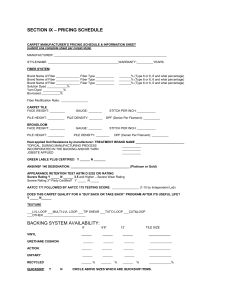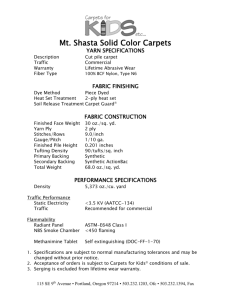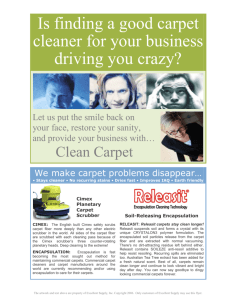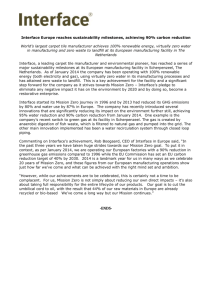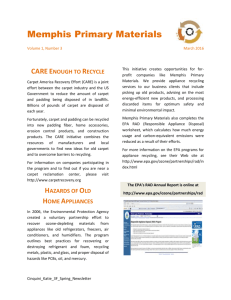King County Environmental Purchasing Program
advertisement
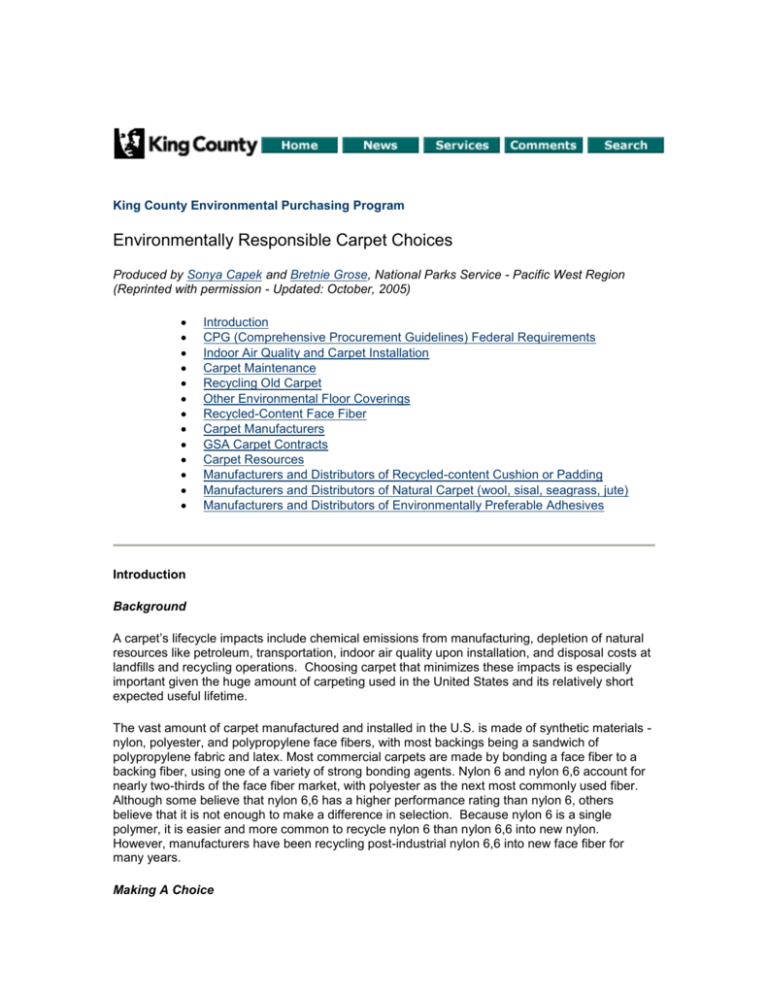
King County Environmental Purchasing Program Environmentally Responsible Carpet Choices Produced by Sonya Capek and Bretnie Grose, National Parks Service - Pacific West Region (Reprinted with permission - Updated: October, 2005) Introduction CPG (Comprehensive Procurement Guidelines) Federal Requirements Indoor Air Quality and Carpet Installation Carpet Maintenance Recycling Old Carpet Other Environmental Floor Coverings Recycled-Content Face Fiber Carpet Manufacturers GSA Carpet Contracts Carpet Resources Manufacturers and Distributors of Recycled-content Cushion or Padding Manufacturers and Distributors of Natural Carpet (wool, sisal, seagrass, jute) Manufacturers and Distributors of Environmentally Preferable Adhesives Introduction Background A carpet’s lifecycle impacts include chemical emissions from manufacturing, depletion of natural resources like petroleum, transportation, indoor air quality upon installation, and disposal costs at landfills and recycling operations. Choosing carpet that minimizes these impacts is especially important given the huge amount of carpeting used in the United States and its relatively short expected useful lifetime. The vast amount of carpet manufactured and installed in the U.S. is made of synthetic materials nylon, polyester, and polypropylene face fibers, with most backings being a sandwich of polypropylene fabric and latex. Most commercial carpets are made by bonding a face fiber to a backing fiber, using one of a variety of strong bonding agents. Nylon 6 and nylon 6,6 account for nearly two-thirds of the face fiber market, with polyester as the next most commonly used fiber. Although some believe that nylon 6,6 has a higher performance rating than nylon 6, others believe that it is not enough to make a difference in selection. Because nylon 6 is a single polymer, it is easier and more common to recycle nylon 6 than nylon 6,6 into new nylon. However, manufacturers have been recycling post-industrial nylon 6,6 into new face fiber for many years. Making A Choice Environmentally responsible carpet options each have their own merits and considerations, and what you choose will in part depend on your specific need, location, and use. Consider the following when deciding on a new carpet: Recycling your old carpet to keep it out of the landfill Using carpet tiles rather than rolls to aid in spot replacement and longer life The type of fiber (i.e., nylon, polyester P.E.T., wool), the recycled content, and the recyclability of the face fiber, backing, and cushion Choosing fiber density and durability for heavy traffic use Choosing colors and patterns that reduce wear Carpet fiber construction (manufactured by tufting, weaving, and fusion bonding, of which tufting is the most common) and pile type (loop, cut, or combination), which determine appearance and performance. Lower pile height and higher pile yarn density is better for high traffic areas and gives the best performance. How and where the carpet will be used. Some people prefer the appearance and durability of nylon to polyester; others will state that recycled polyester (PET plastic) is more durable and naturally stain resistant. Wool carpet is naturally flame resistant, durable, and provides excellent indoor environmental quality, but at a higher cost. Choosing a backing or carpet cushion with high recycled content and/or minimal resource use, choosing to eliminate the need for backing in general when not needed. Indoor air quality and the method of installation – adhesives can emit VOCs and create an unhealthy indoor environment. Floor coverings other than carpet make good environmental choices, and perhaps the best environmental choice is to use carpet only where necessary, and maintain and clean it properly to maximize its life. CPG (Comprehensive Procurement Guidelines) Federal Requirements: Under the Comprehensive Procurement Guideline, Federal agencies are required to purchase items containing recovered materials (pursuant to EO 13101 and Section 6002 of The Resources Conservation and Recovery Act). Sixty-one items are currently listed, including P.E.T. carpet face fiber and carpet cushion. The recommended recovered material content for polyester face fiber is listed as 25-100% P.E.T. resin (recycled plastic soda bottles). The Envirelon (Talisman) line meets this standard. Carpet cushion’s recommended recovered material content varies according to material: 15-50% for bonded polyurethane, 40% for jute, 100% for synthetic fibers, and 60-90% for rubber. For more information, visit EPA’s CPG web site. EPA's recommendations do not preclude a procuring agency from purchasing another type of carpet or carpet cushion. They simply require that procuring agencies, when purchasing P.E.T. carpet or bonded polyurethane, jute, synthetic fiber, or rubber carpet cushions, purchase these items made with recovered materials at levels that meet applicable specifications and performance requirement. Indoor Air Quality and Carpet Installation: Ensure that your new carpet meets indoor air quality standards. The Carpet and Rug Institute (CRI) has an Indoor Air Quality Carpet Testing Green Label which sets carpet standards. Adhering to the CRI standards is recommended, but requiring the CRI Label in specs may eliminate certain carpet manufacturers such as Collins & Aikman which may exceed CRI standards, but do not use the CRI Label. Several manufacturers, including Milliken, Interface, Bentley Prince Street, Mohawk, Shaw, and Collins & Aikmen have either committed to entirely PVC-free manufacturing or produced PVCfree carpet backing. Carpet can be a major source of indoor air contamination. The adhesives used to install carpets and the latex rubber used by some manufacturers to adhere face fibers to backing materials generate volatile organic compounds (VOCs). Carpets also cover large surfaces within an interior environment and can provide “sinks” for the absorption of VOCs from other sources. Installing carpets in strict accordance with CRI guidelines, as well as additional measures such as requiring suppliers to unroll and air-out carpets in the warehouse before bringing them into the building, will minimize the risks of indoor air quality problems resulting from the carpet. Tests indicate that carpet emissions will dissipate within 48 to 72 hours with proper ventilation. Commercial carpets can be installed with water based, low VOC adhesives, or the products can be purchased with preapplied adhesive. Carpet tiles allow for the replacement of individual tiles when they are soiled or damaged, but the production of tiles may require more bonding agents than broadloom. A variety of adhesives are included in the CRI Green Label program; waterbased adhesives are available from the distributors listed below. Rubber-based recycled padding is commonly used and can outgas. Recycled padding made from recycled carpet fibers may be more suitable for environmentally sensitive persons. Carpet cushion is tested in the CRI program and a variety of cushion products qualify to carry the CRI Green Label. Carpet Maintenance: Frequent and good maintenance is the key to a long lasting and good-looking carpet. Commercial areas with heavy traffic should be vacuumed daily, with equipment that has powerful suction and an enclosed HEPA filtration bag. Every 6-12 months, the carpet should be extraction cleaned, preferably by hot water or steam. Some methods such as dry foam or dry extraction use chemicals that can emit fumes and cause indoor air quality problems. Clean up spills immediately to prevent stains and fungal growth. Carpet should not be installed near entrance doors or areas where moisture and organic matter can contaminate them. Walk-off mats at entrances should be installed or that portion of carpet should be cleaned more often than less trafficked carpet. Carpet fibers are an excellent medium for dust mites and microbial agents, especially if the carpet becomes wet and cannot be properly dried. Carpet can be purchased treated with antimicrobial agents that resist the growth of microorganisms. Recycling Old Carpet: Purchasing new carpet often means an old carpet must be discarded. It is important that the old carpet be kept out of the landfill and recycled into new products instead. There are several major methods of recycling: chemical recycling, which involves breaking down the nylon itself to be reprocessed into new carpet fiber; fiberizing, where carpet fibers are harvested and converted into backing, padding, and matting for use in laying new carpet; and mechanical, where carpet fibers are down cycled into different products. Materials can be processed into products such as parking barriers, geotextiles, lumber alternatives, fiberboard, sod reinforcement, carpet tack strip or automobile parts. Because separating yarn from the backing can be difficult, some manufacturers have developed a coding system. A bar code is stamped on the back of the carpet to identify all of the materials used in it. Several manufacturers have their own take-back program for the end of the life of the carpet, particularly when installing a new carpet. (Examples are provided below) Other Environmental Floor Coverings: Floor coverings other than carpet make good environmental choices, and perhaps the best environmental choice is to use carpet only where necessary. The following carpet alternatives could be considered: Natural linoleum is made from softwood powder, linseed oil, pine tree resins, cork, chalk, and jute backing. Natural linoleum uses renewable resources and offers durability without compromising aesthetics. The cork used in linoleum is harvested from the cork tree on an ongoing basis without harming the tree. Linoleum products include Marmoleum by Forbo Industries, Marmorette by Armstrong, and Linosom by Domco. Natural linoleum costs more than low-cost vinyl flooring, but durability and low-maintenance makes life-cycle costs lower. Bamboo is a fast-growing, renewable flooring material with sustainable forest management practices. Natural carpets are made from grasses, cotton, and wool, with minimal treatment. Wool carpet is made from a renewable resource and is durable and biodegradable. Natural carpet materials cost more than common carpet materials, but are competitively prices with standard high quality carpeting. Recycled-content tile is made from waste glass such as light bulbs and auto windshields, and a byproduct of feldspar mining. Recycled-content glass tile often costs more than average tile products. Ceramic tile offers outstanding durability and maintainability, with a high aesthetic value. Resilient flooring such as Eco-Surfaces by Dodge-Regupol (100% recycled rubber) and Stratica by the Amtico Company (non-vinyl, VOC-free, chlorine-free flooring), are available. Wood salvaged from existing buildings or from a forest certified as sustainably harvested are excellent environmental options. EcoTimber manufactures wood flooring from reclaimed, certified wood and other wood alternatives. Concrete also offers a durable environmental alternative by using fewer resources when a concrete slab is made into a finished floor by adding color, texture, and patterns to the top layer of concrete with no additional covering. Recycled-Content Face Fiber: While many factors contribute to the overall life-cycle costs of a carpet, one way companies can reduce impacts of the manufacturing process is to use recycled content in the face fiber of the carpet. Presently, most recycled nylon comes from post-industrial fiber (waste from extrusion and yarn mills, clean lint and edge trim from finishing lines) but the technology is rapidly improving to convert used nylon fiber into new carpet. As more used carpet becomes available and manufacturing plants adapt their facilities to meet the new technology, the percent of postconsumer content should increase. Keep in mind that the amount of post-industrial content should not be a selection criterion, because as companies become more efficient at reducing waste in the manufacturing process, the percentage of post-industrial recycled content in commercial yarn should drop. It may not be possible to specify the type of face fiber or the amount of recycled content, but you can choose carpet manufacturers who choose one of the following fibers. P.E.T. Carpet made with recycled P.E.T. (e.g., soda bottles) face fibers often has the highest percentage recycled content. P.E.T. fibers are naturally stain resistant and do not require the chemical treatments used on some nylon carpet. Fibers retain their color and resist fading due to sun or harsh cleaning. Shades can be richer and brighter than those found in nylon yarns. P.E.T. carpet manufacturers claim P.E.T. is superior to lower grades of virgin synthetic fibers and that is has exceptional strength and durability. At the time of this report, no programs to recycle used P.E.T. carpet back into new carpet exist, but fibers can be down-cycled into other products such as car parts, insulation, transportation devices, and furniture stuffing. Nylon Nylon carpet uses one of two types of nylon face fiber – nylon 6 or nylon 6,6. Recycled content percentages are often lower in both types than P.E.T. carpets, but nylon fibers, particularly nylon 6 fibers, are often easier to recycle at the end of its life. All of the following nylon manufacturers’ recycled content levels are Scientific Certification Systems (SCS)-certified. Honeywell Infinity Forever Renewable Nylon: The Infinity Forever Renewable Nylon is nylon 6 made from recycled nylon 6 carpet fibers. (Recycled content percentages vary). Used in Mohawk Commercial carpets. Recycled content comes from the Evergreen Nylon Recycling program, 877N6-CYCLE. www.infinitynylon.com Honeywell Zeftron Nylon: Zeftron Nylon has three nylon 6 lines of face fiber that use a range of recycled content. Zeftron Savant uses the highest, with 50% total recycled content, 25% of which is post-consumer. Zeftron Select and Zeftron Solure both contain 25% post-industrial recycled content. www.zeftronnylon.com Recycled content comes from the 6ix Again closed loop recycling program. www.zeftronnylon.com/main/enviro/6ixagain.cfm Invista Antron Nylon: Invista manufactures three nylon 6,6 face fiber products with recycled content - Antron Legacy, Antron nylon with StainResist, and Antron Lumena. Antron Lumena comes standard with at least 5% recycled content, with all three lines containing 90% postindustrial content on a select basis, depending on the carpet manufacturer. The Invista Reclamation Program will reclaim any carpet when specified in the installation of a new carpet. 877-5-ANTRON http://antron.invista.com DuPont: Sorona fibers – biobased “Bio-PDO” corn-sugar derived chemical, but currently with limited availability in carpets. www.dupont.com/sorona Carpet Manufacturers Incorporating sustainability into carpet manufacturing means more than putting recycled content into face fiber. Many companies offer recycled content backing, modular tiles that extend carpet life, recycled content cushion, durability, low- or no-VOC adhesives, techniques that eliminate the need for adhesives, refurbishing programs that extend carpet life, and recovery programs that keep carpets out of the landfill. Several manufacturers have even committed to reduce the lifecycle impacts of carpet by reducing emissions at manufacturing plants, using solar or other renewable energy to power their plants, and making a commitment to reducing waste, toxics, and non-renewable resource depletion. Consider all of these impacts when choosing a carpet manufacturer. INTERFACE FLOORING: 800-336-0225 Interface Flooring has been a leader in sustainability, and their product lines offer many environmental options. All of their flooring meets CRI standards, the Intersept line offers an antimicrobial preservative, and modular tiles extend carpet life. Interface introduced an organically grown and biodegradable corn-based polymer called PLA (see product lines). Interface also introduced their Cool Carpet, an effort to mitigate the emissions that result from all parts of a carpet’s life cycle – from the extraction of raw materials to disposal at the end of its life. When a customer specifies Cool Carpet, Interface funds greenhouse-gas reduction projects estimated to offset the climate damage caused by the carpet. Product Lines Vertical Circles – uses a biobased fiber made from a blend of polylactic acid and nylon. Available for modular flooring in three products – Metamorphic, Syncronicity, and Kinesis. Entropy – Biomimicry design that focuses on minimizing materials, with a total of 45% recycled content (27% post-industrial, 22% post-consumer) Sabi – Raw materials reduction, high recycled content in face fiber and backing, with a total of 51% (29% post-industrial, 22% post-consumer) Prairie School – Raw materials reduction, high recycled content in face fiber and backing, with a total of 54% (32% post-industrial, 22% post-consumer), GlasBac RE recycled content backing used Backing GlasBac RE – a layer of 100% recycled vinyl composite incorporated into the backing, with the backing containing at least 40% total recycled content by weight (20% post-consumer) NexStep – PVC-free cushion backing system Recycling 888-RE-ENTRY ReEntry – Interface Carpet Reclamation Program. If carpet is purchased from Interface, the ReEntry program will take back the old carpet and either down-cycle it into other products or energy, recycle it, or repurpose it for reuse through donation. Adhesives Spray adhesives used reduce adhesive use by 50%. GSA Interface offers “one-stop shopping” on GSA which includes removal and recycling of the old carpet, and purchase and installation of the new carpet. BENTLEY PRINCE STREET FLOORING: 800-423-4709, 206-729-7745 Bentley Prince Street, a sister company of Interface, also offers Cool Carpet, an effort to mitigate the emissions that result from all parts of a carpet’s life cycle – from the extraction of raw materials to disposal at the end of its life. When a customer specifies Cool Carpet, Bentley Prince Street funds greenhouse-gas reduction projects estimated to offset the climate damage caused by the carpet. Face Fiber Bentley Prince Street uses nylon 6,6 face fiber - Invista Antron Legacy high recycled content fiber, or Solutia Ultron Renew fiber, both with high post-industrial recycled content, ranging from 23%-100% depending on the product. Adhesives Healthbond Adhesives are water-based, zero calculated VOC, and exceed the CRI Green Label requirements. Backing NexStep – PVC-free cushion backing system Recycling 888-RE-ENTRY Bentley Prince Street participates in Interface Flooring’s ReEntry Carpet Reclamation Program. The ReEntry program will take back old carpet and either down-cycle it into other products or energy, recycle it, or repurpose it for reuse through donation. SHAW CONTRACT GROUP: 800-257-7429 Face Fiber EcoSolution Q nylon contains 25% recycled content and minimizes use of raw materials. Backing EcoWorx backing system is a PVC-free tile backing that can be infinitely recycled into new backing. Contains 40% recycled content. Shaw also has a carpet backing with a polyurethane laminate containing a soybean product, available through Shaw’s Patcraft Commercial products. Indoor Air Quality Exceeds the CRI Green Label Plus standards Recycling 877-502-SHAW Shaw’s Cradle-to-Cradle policy uses an 800# on the back of each carpet tile and allows the user to call Shaw at the end of the carpet’s life to pick up the carpet, free of charge, to be recycled into new carpet. Both EcoSolution Q nylon and EcoWorx backing are specifically designed to be recycled back into new carpet, true cradle-to-cradle recycling. THE MOHAWK GROUP: 800-622-6228 Face Fiber Mohawk uses Honeywell’s Infinity Forever Renewable Nylon in select carpet lines, which contains a minimum of 25% post-consumer and 25% post-industrial recycled content. Other lines include Antron Legacy, Antron Lumena, or Zeftron nylon, all of which contain varying percentages of recycled content. Mohawk also uses recycled PET in their Enviro-Tech residential and some of their commercial lines. Some Mohawk lines use SmartStrand and ColorStrand made with DuPont’s Sorona polymer fibers, a biobased “Bio-PDO” corn-sugar derived chemical. Backing Duraloc AC and MG backings are PVC and chlorine free, use a non-toxic seam sealer, are CRI Green Label certified, and can be recycled. EcoFlex is an ultra-low VOC backing and cushion system. Mohawk reports that with Infinity nylon, backing is often not needed, which reduces resource depletion and improves air quality. Carpet pad may be desired for residential applications, which can be purchased with recycled content. A carpet cushion called BioBalance is made with soybean oil, an environmental alternative to other recycled content cushions. Recycling Like other companies, Mohawk will remove and recycle old carpet upon installation of a new carpet. COLLINS & AIKMEN FLOORCOVERINGS (TANDUS GROUP): 800-248-2878 Face Fiber Collins & Aikmen (C&A) Floorcoverings (owned by Tandus) produces a modular tile line called Habitat that has low life-cycle impacts and 45% overall recycled content (including backing). The Habitat line contains a minimum of 7% post-consumer content and 82% post-industrial content in its face fiber. Backing C&A produces floor coverings with a 100% recycled content backing called ER3. The backing is produced in the company’s closed-loop recycling process and is the standard in the modular tile product line. The 100% recycled content backing results in an overall 34 to 51% total recycled content carpet (when adding in the face fiber weight). Adhesives C&A offers an installation system that eliminates the use of wet adhesives, and no airing out is required. Products with preapplied adhesive are installed using a “peel and stick” method, which virtually eliminates VOCs. Recycling C&A offers a closed-loop take back program called the Infinity Initiative where they will take vinyl backed carpet at the end of its useful life (regardless of the original manufacturer) and guarantee that all of it will be recycled. All C&A products, including ER3 recycled content carpet, can be recycled again and again after their 15-20 year life. GSA C&A offers “one-stop shopping” on GSA which includes removal and recycling of the old carpet, purchase, and installation of the new carpet. MILLIKEN CARPET: 800-257-3987 Milliken Carpet’s manufacturing plants achieved zero waste sent to the landfill starting in 1999 and they were also the first to eliminate PVC from all of their carpet manufacturing. They offer adhesive-free installation and have reduced the amount of raw materials needed in production of their carpet. Backing TractionBack backing requires no adhesives for installation and eliminates VOCs. Recycling and Reuse 877-E2-RENEW Milliken’s Earth Square program renews used modular carpet, and reconditions it for reuse. Carpet tiles can be purchased through Earth Square, or a service installation and maintenance plan can be purchased which includes cleaning, reconditioning, and reinstallation of purchased carpet. Milliken also guarantees that old carpet will be recycled upon installation of a new carpet. Milliken’s Textile and Carpet Care program (888-88M-CARE) encompasses carpet cleaning and maintenance that reduces toxics, increases indoor air quality, and extends the life of the carpet. TALISMAN MILLS (The Envirelon line): 800-482-5466 Uses 100% recycled P.E.T. fiber. Carpet is glued to the subfloor and the backing is polypropylene. BEAULIEU OF AMERICA: 800-227-7211, 706-278-6666 Beaulieu’s residential carpets includes two collections that contain 100% recycled P.E.T. fibers – Styled for Living and Second Nature. Their commercial carpets are nylon, but their modular tile backing, Nexterra, contains 35% recycled content P.E.T. and 50% post-consumer glass. OTHER COMPANIES WITH ENVIRONMENTAL ATTRIBUTES: Blue Ridge Commercial Carpet: Exceeds CRI standards, participates in Honeywell’s 6ix Again and Invista’s Carpet Reclamation programs, uses recycled content in certain products J&J Industries: Encore SD Ultima face fiber contains 25% recycled content, SBR latex backing contains recycled content, partners with fiber manufacturers in reclamation programs (Honeywell, Invista, Solutia) 800-241-5945 Mannington Mills: Products meet CRI standards & LEED for IAQ, recycles carpet into resilient flooring 800-241-4586 Lees Commercial Carpets: Some lines meet CRI standards, SCS-certified for environmental preferability 800-241-2262 Atlas Carpet Mills, Inc.: Uses Invista Antron nylon, biobased BioBalance carpet cushion, CRI certified, participates in Invista’s Carpet Reclamation program 800-523-5647 213-622-2314 GSA Carpet Contracts: These contracts are for use by federal agencies. They can also be used for your information. Carpets with environmental attributes are available on the GSA schedule, including Envirelon, Collins & Aikman, Interface, Bentley Prince Street, Mohawk, Shaw, and more. Depending on the manufacturer, a single contract can include the purchase of a new carpet, installation, and old carpet removal and recycling. To view the GSA schedules for carpet, visit www.fss.gsa.gov, click on “Schedules e-Library” on the lower right-hand side, and type in a search for Federal Supply Schedule 72 I A. GSA Schedule Categories for Carpeting: 31 601 Recycled content and biobased flooring 31 305 Carpet cushion 31 301 & 302 Broadloom carpet 31 303 Carpet tiles 31 602 Flooring recycling programs 31 604 Installation and removal services GSA National Furniture Center – Schedule assistance 703-305-7003 Carpet Resources: The Carpet and Rug Institute (800) 882-8846 Carpet America Recovery Effort Green Seal’s Choose Green Report on Floor Coverings EPA’s Product Stewardship Report on Carpet Environmental Building News & Green Spec Binder State of Minnesota’s National Agreement on Carpet Recovery Janitorial Products Pollution Prevention Project (JP4) Safe & Effective Carpet Cleaning Greenbuilders Sourcebook (Austin, TX) Manufacturers and Distributors of Recycled-content Cushion/Padding or Backing: Fairmont Division (Leggett & Platt): 100% recycled bonded cushion from polyurethane foam. RB Rubber Products: Sells rolls with 97% recycled rubber for carpet underlayment. 800-525-5530 800-475-0010, 773-376-1300 Reliance Carpet Cushion: Uses 100% recycled materials, mainly from the textiles industry, and uses no CFC’s, latex, or chemical additives. Foamex International, Inc.: 100% recycled content in Rebond Carpet Cushion, a bonded polyurethane product. 800-776-3626 800-522-5252 Dodge-Regupol, Inc.: 100% recycled tire rubber carpet pad. Withstands temperatures from 40 to 120 degrees. Free of toxic materials such as PCB, mercury, and formaldehyde. 717-295-3400, 800-322-1923 Dura Undercushions, Ltd.: Carpet pad manufactured in a cellular structure from ground tire scrap rubber granules bonded with latex. Can be installed using either conventional tackless method or by doublestick method. Made from 92% recycled tire rubber. Homasote Company: 4-way floor decking is a structural, noise-deadening sub-floor and insulating carpet underlayment made with 100% recycled content newspaper. 514-737-6561, 800-295-4126 Southwest Fibers (Leggett & Platt): Formaldehyde free; recycled carpet fibers. 254-562-2814 800-257-9491 Manufacturers and Distributors of Natural Carpet (wool, sisal, seagrass, jute): Bloomsburg Carpet Industries: Natural wool carpets Naturlich Natural Home: 100% wool carpeting 800-233-8773 Dellinger Inc. Rugs: Cotton and wool rugs and carpets 707-824-0914 Sinan Co.: Wool and jute carpets, installed by stretching or water-based gluing 706-291-7402 530-753-3104 Manufacturers and Distributors of Environmentally Preferable Adhesives: AFM Enterprises: Makes a non-toxic, waterbased, 3-in-1 Safecoat Adhesive. Franklin International: Titebond Solvent-Free construction adhesive (nearly no VOC’s, 5 gm/ltr) 619-239-0321 DAP Inc.: DAP Weldwood Carpet Adhesive is a low-VOC, latex-based, non-flammable adhesive. 800-347-4583 PL Adhesives & Sealants: “PL Premium” construction adhesive (no VOCs) ChemRex Inc. 888-DAP-TIPS 612-496-6000 Sinan Co.: Water-based “Auro” brand natural adhesive 530-753-3104 This report was compiled by Sonya Capek, Solid Waste Coordinator, and Bretnie Grose, National Park Service, Pacific West Region. Any comments or feedback on this report should be sent directly to them. October, 2005 E-mail Return to Environmental Purchasing Main Menu Updated: October, 2005 King County | News | Services | Comments | Search Links to external sites do not constitute endorsements by King County. By visiting this and other King County web pages, you expressly agree to be bound by terms and conditions of the site. The details.

